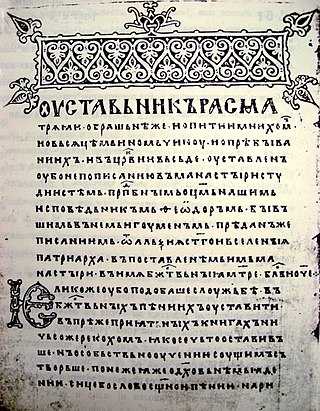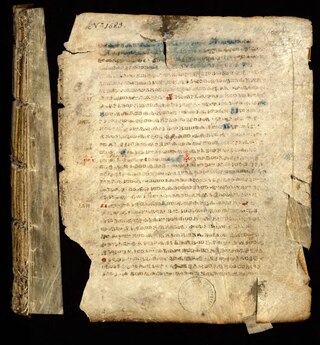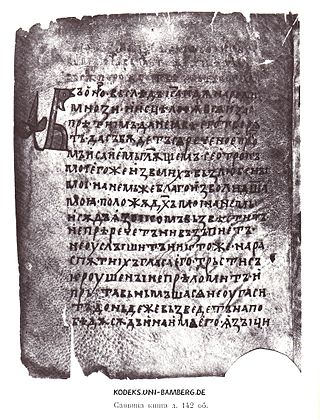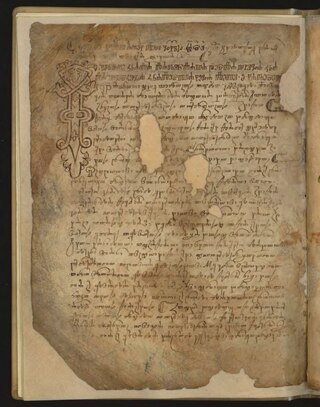
Old Church Slavonic or Old Slavonic is the first Slavic literary language.

Vatroslav Jagić was a Croatian scholar of Slavic studies in the second half of the 19th century.

The Codex Marianus is an Old Church Slavonic fourfold Gospel Book written in Glagolitic script, dated to the beginning of the 11th century, which is, one of the oldest manuscript witnesses to the Old Church Slavonic language, one of the two fourfold gospels being part of the Old Church Slavonic canon.

The Codex Suprasliensis is a 10th-century Cyrillic literary monument, the largest extant Old Church Slavonic canon manuscript and the oldest Slavic literary work located in Poland. As of September 20, 2007, it is on UNESCO's Memory of the World list.

The Kiev Missal is a seven-folio Glagolitic Old Church Slavonic canon manuscript containing parts of the Roman-rite liturgy. It is usually held to be the oldest and the most archaic Old Church Slavonic manuscript, and is dated at no later than the latter half of the 10th century. Seven parchment folios have been preserved in small format of easily portable book to be of use to missionaries on the move.
Codex Assemanius is a rounded Glagolitic Old Church Slavonic canon evangeliary consisting of 158 illuminated parchment folios, dated to early 11th century. The manuscript is created in the Ohrid Literary School of the First Bulgarian Empire.

The Euchologium Sinaiticum is a 109-folio Old Church Slavonic euchologion in Glagolitic script. It contains parts of the liturgy of Saint John Chrysostom, and is dated to the 11th century. It is named after Saint Catherine's Monastery in Sinai, where it was found in the 19th century.

The Glagolita Clozianus is a 14-folio Glagolitic Old Church Slavonic canon miscellany, written in the eleventh century.

Sava's book is a 129-folio Cyrillic Old Church Slavonic canon evangeliary, written in the 11th century.
Uncial 080, ε 20 (Soden), is a Greek uncial manuscript of the New Testament, dated paleographically to the 6th century.
As the 9th-century missionaries Saints Cyril and Methodius undertook their mission to evangelize to the Slavs of Great Moravia, two writing systems were developed: Glagolitic and Cyrillic. Both scripts were based on the Greek alphabet and share commonalities, but the exact nature of relationship between the Glagolitic alphabet and the Early Cyrillic alphabet, their order of development, and influence on each other has been a matter of great study, controversy, and dispute in Slavic studies.

Law code of Vinodol or Vinodol statute is one of the oldest law texts written in the Chakavian dialect of Croatian and is among the oldest Slavic codes. It was written in the Glagolitic alphabet. It was originally compiled in 1288 by a commission of 42 members in Novi Vinodolski, a town on the Adriatic Sea coast in Croatia, located south of Crikvenica, Selce and Bribir and north of Senj. However, the code itself is preserved in a 16th-century copy.

Bible translations into Serbian started to appear in fragments in the 11th century. Efforts to make a complete translation started in the 16th century. The first published complete translations were made in the 19th century.

The Munich Serbian Psalter is a 14th-century illuminated psalter written in Church Slavonic of the Serbian recension. With its 229 leaves illustrated with 148 miniatures, it is regarded as the most extensively illuminated Serbian manuscript book. It was written after 1370 in Moravian Serbia, either for its ruler Prince Lazar, or more likely, for his successor Stefan Lazarević. The book was rebound in 1630 by Serbian Patriarch Pajsije. It was taken to Bavaria in the late 17th century, and has been kept in the Bavarian State Library in Munich since the beginning of the 19th century.
Jovan Maleševac was a Serbian Orthodox monk and scribe who collaborated in 1561 with the Slovene Protestant reformer Primož Trubar to print religious books in Cyrillic. Between 1524 and 1546, Maleševac wrote five liturgical books in Church Slavonic at Serbian Orthodox monasteries in Herzegovina and Montenegro. He later settled in the region of White Carniola, in present-day Slovenia. In 1561, he was engaged by Trubar to proof-read Cyrillic Protestant liturgical books produced in the South Slavic Bible Institute in Urach, Germany, where he stayed for five months.

Medieval literary heritage of Bosnia and Herzegovina, as part of a Bosnia and Herzegovina literature, is based on local language traditions and literacy and can be assessed starting with the High Middle Ages. The oldest preserved Bosnian inscriptions is considered to be the Humac tablet, inscribed into stone tablet between the 10th and 12th century, which means that probably predates Charter of Ban Kulin written on 29 August 1189.

The Rila fragments are a Glagolitic manuscript consisting of eight fragmentary parchment leaves and three fragments of a 10th-century Glagolitic Old Church Slavonic book.

The Bojana Palimpsest or Bojana Gospel is an 11th-century Old Church Slavonic manuscript, originally written in a Glagolitic manuscript. In the 13th century, the Glagolitic text was removed, and the parchment was reused to write a Cyrillic gospel.
![Codex Zographensis
with the beginning of Mark's Gospel "[] (Ievaggielyie ot' Mar'ka)" (Saint Petersburg, National Library of Russia, Ms. glag. 1, f.77r) ZographensisColour.jpg](http://upload.wikimedia.org/wikipedia/commons/thumb/8/87/ZographensisColour.jpg/200px-ZographensisColour.jpg)















